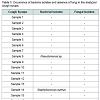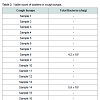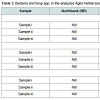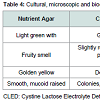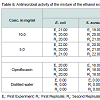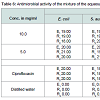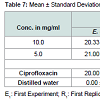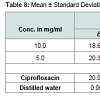Journal of Microbiology & Microbial Technology
Download PDF
Research Article
*Address for Correspondence: Agbulu Christiana Onyemowo, Department of Biological Sciences, College of Science, University of Agriculture, Makurdi, Benue State, Nigeria, Tel: 07068663822; E-mail: christianaagbulu@gmail.com
Citation: Agbulu CO, Ameh EA, Ocharifu SA. Microbiological Quality of Cough Syrups and Herbal Solutions ‘Agbo’ Sold in Makurdi Metropolis of Benue State, Nigeria. J Microbiol Microb Technol 2016;1(1): 6.
Copyright © 2016 Agbulu CO, et al. This is an open access article distributed under the Creative Commons Attribution License, which permits unrestricted use, distribution, and reproduction in any medium, provided the original work is properly cited.
Journal of Microbiology & Microbial Technology | Volume: 1, Issue: 1
Submission: 05 April, 2016 | Accepted: 02 May, 2016 | Published: 06 May, 2016
Reviewed & Approved by: Dr. Aishwarya Devaraj, Center for Microbial Pathogenesis, Nationwide Children’s Hospital, USA
Microbiological Quality of Cough Syrups and Herbal Solutions ‘Agbo’ Sold in Makurdi Metropolis of Benue State, Nigeria
Agbulu Christiana Onyemowo1*, Ameh EA 1, Ocharifu SA2
- Department of Biological Sciences, College of Science, University of Agriculture, Makurdi, Benue State, Nigeria
- Sisters of Nativity Hospital, Jikwoyi, Abuja, Nigeria
*Address for Correspondence: Agbulu Christiana Onyemowo, Department of Biological Sciences, College of Science, University of Agriculture, Makurdi, Benue State, Nigeria, Tel: 07068663822; E-mail: christianaagbulu@gmail.com
Citation: Agbulu CO, Ameh EA, Ocharifu SA. Microbiological Quality of Cough Syrups and Herbal Solutions ‘Agbo’ Sold in Makurdi Metropolis of Benue State, Nigeria. J Microbiol Microb Technol 2016;1(1): 6.
Copyright © 2016 Agbulu CO, et al. This is an open access article distributed under the Creative Commons Attribution License, which permits unrestricted use, distribution, and reproduction in any medium, provided the original work is properly cited.
Journal of Microbiology & Microbial Technology | Volume: 1, Issue: 1
Submission: 05 April, 2016 | Accepted: 02 May, 2016 | Published: 06 May, 2016
Reviewed & Approved by: Dr. Aishwarya Devaraj, Center for Microbial Pathogenesis, Nationwide Children’s Hospital, USA
Abstract
Orthodox cough syrups and a local herbal preparation called ‘Agbo’ in Nigeria (a mixture of the extracts of the barks of Enantia chlorantha and Nauclea latifolia, stem of Anogiessus leiocarpus and the stem bark of Khaya grandifoliola) are highly patronized cough medicines in Makurdi, Benue State, Nigeria. Samples (n = 60, consisting 24 cough syrups produced by different pharmaceutical companies, sourced from different pharmacy shops and 36 Agbo samples: three samples collected from each of three different vendors in three areas) were analysed for any microbial contamination using culture techniques and biochemical tests. One brand of the cough Syrup yielded S. aureus (5.9 x 104 cfu/ml) and another syrup yielded Pseudomonas spp. (4.2 x 104 cfu/ml). No bacterial and fungal growth in the rest of the samples. The spectrum of antimicrobial activity of Agbo at 5 mg/dl and 10 mg/dl concentrations on Staphylococcus aureus, Pseudomonas aeruginosa, Escherichia coli, Klebsiella pneumonia, Candida albicans and Aspergillus flavus using ciprofloxacin and distilled water as positive and negative controls respectively were also determined. Mixture of the ethanolic extracts of the Agbo plants have antibacterial activity at 5 mg/dl and 10 mg/dl, with less antifungal activity. At the same concentration, the mixture of the aqueous extracts also has antibacterial activity but no antifungal activity. The zone of inhibition of the ethanolic extracts was slightly greater than that of the aqueous extracts on the bacteria spp. at both concentrations. At the lower concentration, the zone of inhibition was seen to be higher for both the ethanolic and aqueous extracts. Greater inhibition of A. flavus, was seen at both concentrations compared to C. albicans. The bacterial contamination of the two cough syrups raises an alert and the ‘Agbo’ stimulates interest.Keywords
Cough syrups, Microbial contamination, Agbo inhibitionIntroduction
Microbial contamination refers to the presence of undesired microbes or their metabolites, which may be pathogenic or merely causes spoilage or degradation in an environment [1]. Raw materials account for a high proportion of microorganisms introduced into the products during manufacturing hence selection of materials of a good microbiological quality aids in the control of contamination of products [2]. Coughing is a reflex action started by stimulation of sensory nerves in the lining of the respiratory passages - the tubes we use to breathe [3]. It could also be a sign of an infection in the lungs that is affecting the respiratory passages.Syrups are popular non-sterile dosage forms of administering active medicaments to babies, children and the elderly [4]. Syrups are prepared for oral administration in children since tablets and capsules cannot be easily or conveniently administered to them [5]. Traditional medicine can be described as the total combination of knowledge and practices, whether explicable or not, used in diagnosing, preventing or eliminating a physical, mental or social disease and which may rely exclusively on past experience and observation handed down from generation to generation, verbally or in writing [6].
Medicinal plants are plants which one or more of its organ contain substance that can be used for therapeutic purposes or which are precursors for the synthesis of useful drugs [7].
According to the producers and vendors, Agbo herb is used in the treatment of malaria, typhoid, cough, and convulsions. It is a multi-herbal preparation produced with the water from pap (akamu), water from soaked guinea corn and lime.
The plants used are Enantia chlorantha (bark), Anogiessus leiocarpus (stem), Khaya grandifoliola (stem bark) and Nauclea latifolia (bark). Agbo is well known among the Yoruba people in the western part of Nigeria. The name Agbo is the local name of this herbal preparation [8].
Treatment of cough is not an exceptional use of Agbo according to the herbalists. In 2005, Adeleye et al. worked on the microbial contamination of herbal preparations in Lagos, Nigeria [8].
In their study, they found out that medicinal plant materials normally carry a large number of microbes originating from the soil. Additional contaminants may also be introduced during harvesting, handling and production.
In 2009, Muhammed and Umoh reported the incidence and effects of microorganisms on the quality of some pharmaceutical mixtures in Zaria-Nigeria [4]. The process of preparing Agbo and the raw materials used in preparing it in Makurdi is a cause for concern as it is sometimes a suitable environment for the multiplication of microbes.
Also, the handling, packaging and production environment of some cough syrups predisposes the product to microbial contamination.
These products (pharmaceutical cough syrups and Agbo) are widely taken and Makurdi is not excluded, but there is scanty information about the microbiological quality of these products in Makurdi metropolis.
Objectives
• To isolate and identify microorganisms present in cough syrups and Agbo herbal solution used for treating cough.• To ascertain the level of contamination with pathogenic organisms, so as to determine their suitability for consumption.
• To compare the extent of microbial contamination in cough syrups and Agbo herb.
Materials and Methods
Collection of samplesA total of 60 samples were collected, out of which 24 cough syrups were gotten from different pharmaceutical stores in Makurdi. 9 samples of Agbo were gotten from three different vendors (three samples from each vendor) in each of North-Bank, Wurukum, Wadata as well as Modern Market.
The samples were maintained in an ice-packed container immediately after collection and transported to the laboratory where analysis was carried out after 4 days of collection.
Bacteriological examination
Serial dilution, pour plate method, streak method, innoculation and incubation where done. Isolation and identification using gram staining, motility, catalase, coagulase test and other biochemical test [9].
Collection and identification of herbal plant parts
The stem and stem barks of the plants (Enantia chlorantha - bark, Anogiessus leiocarpus - stem, Khaya grandifoliola - stem bark, and Nauclea latifolia - bark). The plants were identified in the Department of Forestry, Federal University of Agriculture, Makurdi, Benue State. The plants were also cross checked by various herbalists at an herbal trade fair held at the Aminu Isa Kotongora Arts Theatre Complex, Makurdi.
Source of typed organism
Staphylococcus aureus, Pseudomonas aeruginosa, Escherichia coli, Klebsiella pneumonia, Candida albicans and Aspergillus flavus were stock cultures collected from the Microbiology section, TOSEMA Diagnostic Laboratory, Makurdi, Benue State.
The bacterial isolates were sub-cultured on Nutrient Agar slants while the fungal isolates were sub-cultured on Sabouraud Dextrose Agar slants and stored in the refrigerator at 4 ºC prior to use.
Preparation of Plant Extracts
• Dried powders of the plants were prepared and the ethanol extract was carried out according to the methods of Babamale [10].• Broth cultures were prepared and incubated.
• Antimicrobial activities of the plant extract were determined using Lamikara et al. method [11].
Results
Occurrence of bacteria isolates in the analysed cough syrups showed Staphylococcus aureus was found in one of the cough syrups while Pseudomonas spp. occurred also in one brand of the syrups. There was no fungal growth (Table 1).Table 2 shows the viable count of bacteria in cough syrups. 4.2 x 104 of Pseudomonas spp. and 5.9 x 104 of Staphylococcus aureus in two different cough syrups.Table 3 shows there was no bacteria growth and fungal growth respectively from the analyzed Agbo herbal solution from North- Bank, Wurukum, Wadata and Modern market areas of Makurdi Metropolis.Table 4 analyzed the cultural, microscopic and biochemical characteristics of suspected bacteria isolates. Two bacteria were isolated from the entire samples.The mixture of the ethanolic extracts of Agbo plants have antimicrobial effect at concentrations 10 mg/ml and 5 mg/ml on the bacteria and fungi isolates, with less antimicrobial effect on the fungi isolates (Table 5).Table 6 shows that the mixtures of the aqueous extracts of Agbo plants have antimicrobial effect at concentrations 10 mg/ml and 5 mg/ml on only the bacteria isolates and no antimicrobial effect on the fungi isolates at both concentrations.Table 7 analyzes the Mean ± Standard Deviation of the zones of inhibition of the ethanol extracts of the mixture of Agbo plants at concentrations 10 mg/ml and 5 mg/ml, it was slightly high at the lower concentration for all the isolates. The fungal isolates had the least at both concentrations. Mean ± Standard Deviation of the zones of inhibition of the aqueous extracts of the mixture of Agbo plants at concentrations 10 mg/ml and 5 mg/ml, it was slightly high at 5 mg/ml for the bacteria isolates. For the fungi isolates, there was no zone of inhibition (Table 8).The ethanolic and aqueous extracts on the bacteria isolates showed a slight difference with the positive control (ciprofloxacin) while the fungal isolates showed a marked difference with ciprofloxacin. There was no antimicrobial activity on the isolates by the negative control (distilled water).Discussion
The results of this study revealed that only two cough syrups out of the 24 cough syrups analysed were contaminated. The cough syrups were contaminated with only bacteria spp.. This can be seen from the high microbial counts obtained in the 2 cough syrups containing Pseudomonas spp. and S. aureus. The results revealed that the samples tested had high microbial levels according to the BP specification of 103 - 104 cells/ml [4]. One was more contaminated with Staphylococcus aureus and another with a higher count of Pseudomonas spp.. It may be that since S. aureus is a normal flora of the body, it can contaminate products through handling. According to Frazier and Westhoff, Staphylococcus spp are able to survive in fairly high concentration of sugar, although favourable growth of microorganisms is prevented by the high sugar concentration in cough syrups [12]. The heat resistance of staphylococcus spp. also contributes to their survival in processed products [4]. The presence of Pseudomonas spp. could be from the environment, mostly the soil.Possible aseptic measures that prevent the introduction of fungi spp. during production, processing and handling could have resulted in the absence of fungi spp. in the cough syrups.The absence of bacteria and fungi spp. in the Agbo herbal solution could be from the inhibitory effects of the bioactive substances in both the aqueous and ethanol extracts of the plants used in producing Agbo.
The result also revealed the presence of antimicrobial substances at concentrations 5 mg/ml and 10 mg/ml of both the ethanolic and aqueous extracts of the Agbo plants. The zone of inhibition of the ethanolic extracts was slightly greater than that of the aqueous extracts on the bacteria spp. at both concentrations. This might be due to proper dissolution of the bioactive substances of the plants in ethanol than in water. At the lower concentration, the zone of inhibition was seen to be higher than it was at the higher concentration for both the ethanolic and aqueous extracts. This could possibly mean that the extracts function best at lower concentration.
The ethanolic extracts had a very little antimicrobial effect on the fungi spp. at both concentrations with the lower concentration having a greater zone of inhibition. On A. flavus, a greater inhibition was seen at both concentrations compared to C. albicans. The aqueous extracts had no antimicrobial activity on the fungi spp., this is in line with an earlier work by Adekunle and Odukoya [13]. It could be due to the fact that the bioactive substances of the plants could not dissolve properly in water in such an amount that could inhibit fungal growth.
The inhibition of the ethanol extracts compared to ciprofloxacin at both concentrations was a little higher on the bacteria spp.. On the fungi spp. there was a marked difference with ciprofloxacin having greater antimicrobial activity. Distilled water had no inhibition.
The inhibition of the aqueous extracts compared to ciprofloxacin at both concentrations was a little lower on the bacteria spp.. There was no inhibition on the fungal spp. by the aqueous extracts at both concentrations but a remarkable inhibition on the fungi spp. at both concentrations by ciprofloxacin was seen. Distilled water had no antimicrobial activity on the fungi spp..
The aqueous extracts at 10 mg/ml had the highest inhibition on S. aureus and the lowest on K. pneumoniae. At 5 mg/ml the inhibition was almost the same for all the bacteria spp..
The ethanol extracts at 10 mg/ml had the highest inhibition on P. aeruginosa and the lowest on S. aureus and K. pneumonia. At 5 mg/ ml the highest inhibition was seen on P. aeruginosa followed by K. pneumoniae. Equal zone of inhibition was seen on E. coli and S. aureus at 5 mg/ml. A lower zone of inhibition compared to the bacteria spp. at both concentrations was seen on the fungi spp.. Aspergillus flavus had a slightly high inhibition compared to C. albicans. In conclusion, cough syrup contamination have been recorded although in just 2 out of the 24 samples analysed, it is a cause for concern as the level of contamination can easily lead to microbial infection. This study have also revealed the high antimicrobial activity of the plants used in producing Agbo herbal solution (for treating cough), the reason for the absence of bacteria and fungi in the Agbo herbal samples (for cough), making the herbal solution safe for consumption.
• Complete aseptic measures should be ensured in the production, handling and packaging of cough syrups.
• Routine test for microorganisms should be carried out during production of cough syrups so as to avoid the presence of microorganisms in the product.
• Appropriate authorities and bodies should regularly monitor the production of cough syrups, the raw materials used and the environment. This is to ensure compliance with hygienic and sanitary standards.
• Producers and vendors of Agbo herbal solution should imbibe and adhere to sanitary and hygienic practices so as to make potential users believe in the safety of the product.
• Appropriate authorities and bodies should encourage individuals to obtain Agbo herbal solution as it is safe for consumption. Agencies such as NAFDAC in Nigeria could create an avenue where Agbo herbal solution will be certified to ensure the safety of the product.
References
- Uba LM (1990) The effect of the microbial level of finished products. Bachelor of Pharmacy Thesis, Faculty of Pharmaceutical Science, Ahmadu Bello University Zaria-Nigeria
- Underwood E (1992) Eclogy of microorganism as it affects pharmaceutical industries. In: Hugo WB, Russel AD (Eds). Pharmaceutical Microbology (5th edn). Blackwell Scientific Publication, London, pp. 353.
- Pillinger J (2011) Coughing: Decades Research. Food Res Int 38: 77-86.
- Muhammed A, Umoh VJ (2009) Incidence and effects of microorganisms on the quality of some pharmaceutical mixtures in Zaria-Nigeria. Niger J Pharm Sci 8: 126-134.
- Adeshina GO, Ajayi S, Onaolapo JA (2009) Microbiological quality of some commercially available paediatric anti-malarial and cough preparations in Ilorin, Nigeria. Niger J Pharm Sci 8: 109-177.
- Sofowora A (1982) Medicinal plants and traditional medicine in Africa. John Wiley and Sons limited, pp. 250.
- Kadiri AB (2008) Evaluation of medicinal herbal trade (Paraga) in Lagos state of Nigeria. Ethnobotanical Leaflets 2008.
- Adeleye IA, Okogi G, Ojo EO (2005) Microbial contamination of herbal preparations in Lagos, Nigeria. J Health Popul Nutr 23: 296-297.
- Cheesbrough M (2000) District laboratory practice in tropical countries part 2. Cambridge University Press, United Kingdom, pp. 35, 38, 64, 65, 157-195.
- Babamale MS (2007) Antimicrobial activity of aqueous extracts of chewing stick from Azadiratcha indica on dental carries.
- Lamikara A, Ogundaini AO, Ogungbamila FO (1990) Antibacterial constituents of Alchornea cordifolia leaves. Phytother Res 4: 198-200.
- Frazier WC, Westhoff DC (1994) Food Microbiology. 4th edn.
- Adekunle AA, Odukoya KA (2006) Antifungal activities of ethanol and aqueous crude extracts of four Nigerian chewing sticks. Ethnobotanical Leaflets 2006.


